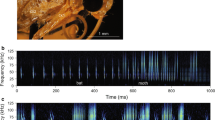Abstract.
Natterer's bats, Myotis nattereri, continued to emit echolocation calls while gleaning non-flying arthropods, and made little use of prey-generated sound as a cue to locate them. Feeding buzzes were recorded during most attacks. In contrast, brown long-eared bats, Plecotus auritus, in parallel experiments, stopped echolocating during the hovering phase of gleaning attacks, did not emit feeding buzzes and used prey-generated sound as a cue to find food. In uncluttered foraging situations, M. nattereri were able to locate prey by echolocation alone, but in clutter they may have combined it with associative learning, and may also have gleaned prey after being attracted to food sources by feeding buzzes from conspecifics. Both in a flight room and in the wild, Natterer's bats foraged using a sequence of low searching flight, hovering, capture using the interfemoral membrane and prey consumption at a perch or on the wing. They also landed and pursued prey by quadrupedal locomotion. Their diet consisted mainly of medium-sized (5–15 mm body length) arthropods, particularly dungflies, spiders, beetles and harvestmen, active on plant surfaces at night, some of which could only have been captured by gleaning. Moths were eaten in relatively small quantities, suggesting that the bats were unable to hear their fluttering sounds or that tympanate moth species could detect the bats' approach and take avoiding action. In the same area, moths formed the major component of the diet of P. auritus, reflecting the different foraging techniques of the two bat species.
Similar content being viewed by others
Author information
Authors and Affiliations
Additional information
Electronic Publication
Rights and permissions
About this article
Cite this article
Swift, .S., Racey, .P. Gleaning as a foraging strategy in Natterer's bat Myotis nattereri . Behav Ecol Sociobiol 52, 408–416 (2002). https://doi.org/10.1007/s00265-002-0531-x
Received:
Revised:
Accepted:
Issue Date:
DOI: https://doi.org/10.1007/s00265-002-0531-x




